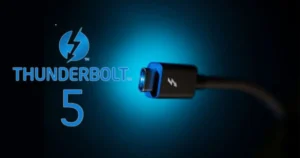The 14th generation of Intel Raptor Lake CPUs were just unveiled. Once again, the performance of these highly anticipated chips has impressed. For example, the 14th generation CPUs include P-cores that can reach up to 6 GHz, which is 200 MHz faster than the 12th generation processors. Nevertheless, despite their superior performance and cutting-edge capabilities, the new CPUs have a major flaw. The release from Intel states that Thunderbolt 5 is not supported by desktop CPUs from the 14th generation. These are the specifics.
Intel 14th-Gen Desktop Processors Do Not Support Thunderbolt 5
For those of you who don’t know, Intel has produced the most recent version of the Thunderbolt interface, called Thunderbolt 5. Using this technique, PCI Express and DisplayPort are combined into a single serial signal via a common bus interface. It has the ability to transmit data and video via a single wire.

Thunderbolt 5 doubles the speed of Thunderbolt 4 with a bi-directional bandwidth capability of up to 80 Gbps. You may transfer data, reflect screens, and use Thunderbolt 5 for a wide range of applications. As a matter of fact, laptops are known to often employ this technology. Thunderbolt 5 is not supported by Intel desktop CPUs from the 14th generation, though.

Since Intel had previously said that the 14th-generation CPUs will support the new connection standard, many were taken aback by this. Since then, though, the firm has made it clear that this technology is limited to future laptop CPUs built on the Meteor Lake architecture.
Although it is unfortunate that desktop CPUs from the 14th generation do not support Thunderbolt 5, it is crucial to remember that the technology is still in its infancy. It is anticipated that only high-end computers would initially support it, and that it won’t be publicly accessible until 2024.
